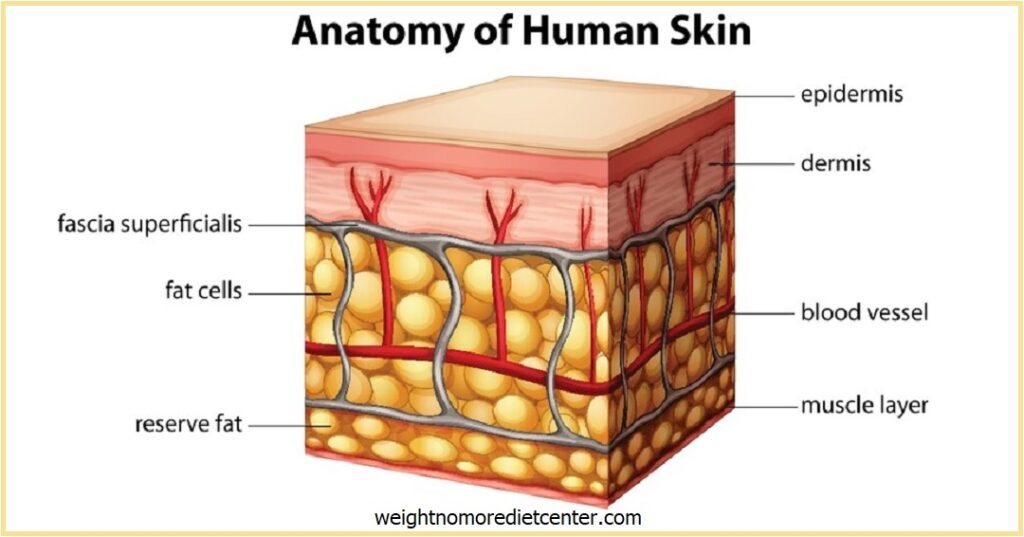The Skinny on Obesity and Your Skin
Weight★No★More℠ Diet Center
Everyone knows the long list of medical issues associated with obesity: heart disease, diabetes, high cholesterol, fatty liver disease, sleep apnea and too many others to list here. Few, however, realize all the ways that excess weight can affect the health and appearance of our skin — a very important (and our largest!) organ.
1. Acne. Sebum plays a major role in acne development. It is an oily substance produced by sebaceous glands to keep the skin moisturized and supple. Acne occurs when the sebaceous channels are blocked and infected. Acne is clearly exacerbated by obesity-associated disorders. Additionally, in obese people, androgens (male hormones) and insulin are raised (insulin resistance), and these are known risk factors for acne.
2. Acanthosis Nigricans. A body that carries too much weight undergoes shifts in hormone levels. Acanthosis nigricans is associated with insulin resistance and, as such, is a very common skin problem in obesity, and one that I see very often in young obese women who have PCOS (polycystic ovary syndrome). Acanthosis nigricans appear as dark patches on the skin, most commonly seen in the arm pits, groin, back of the neck, elbows, knuckles and face.
3. Blood Vessels of the Skin. Obesity changes blood circulation of the skin leading to obesity-related microangiopathy (small blood vessel disease) and hypertension. Blood flow in the skin is increased in obese individuals.
4. Collagen structure and function and wound healing. Obesity is also associated with changes in collagen structure. Collagen forms the structure of the skin and helps in wound healing. However, obese patients rarely manifest facial wrinkles and weakening of the skin or skin laxity due to increased subcutaneous fat.
5. Corns and Calluses. The strain of weight can extend down into your feet, pressing skin against the insides of shoes and rubbing painful corns onto the toes.
6. Intertrigo. Intertrigo is a very common inflammatory condition affecting areas of skin that are in contact with each other. Folds and creases in the skin can trap moisture, which can allow spots on your body to become breeding grounds for bacteria, yeast, and fungi in such areas as the groin, armpits, under the breasts and skin folds.
7. Lymph channels. Obesity impedes or slows lymphatic flow. This leads to collection of protein-rich lymphatic fluids in the subcutaneous (under the skin) tissue. This is called lymphedema.
8. Psoriasis is an autoimmune condition which causes red, scaly patches on the skin. Once thought to affect only the skin, psoriasis is now known to reflect systemic and chronic immune-related inflammation. Obesity is associated with inflammation; losing weight may improve psoriasis by quelling inflammation.
9. Skin barrier function. Obesity increases water loss across the skin to a great extent. The skin of the morbidly obese is significantly dry, and skin repair after wounds is impaired.
10. Stretch marks. When weight is rapidly gained or lost, stretch marks usually arise on the skin’s surface. These are long plaques found in areas with greatest tension and are commonly found on the breasts, buttocks, abdomen, and thighs. Stretch marks start out pink then gradually become red, then purple.
11. Varicose Veins. The strain of bearing excess weight impacts the veins in your legs and can result in varicose veins and rupture of surface capillaries.
The skin is unique in many ways, and no other organ demands so much attention and concern in both states of disease and health. Anti-aging and skin care experts always talk about the importance of putting the right ingredients into our bodies to cultivate and maintain healthy skin. However, obesity is a chronic health problem with numerous complications that affect the skin—some may be simply annoying; others may be indicators of systemic disorders.
You are what you eat. The way you eat, your overall diet, is what keeps your body slim and healthy or obese and unhealthy, but its impact doesn’t stop there. The food you eat matters to your skin almost as much as it does to your waistline.
Slimcerely yours℠,



